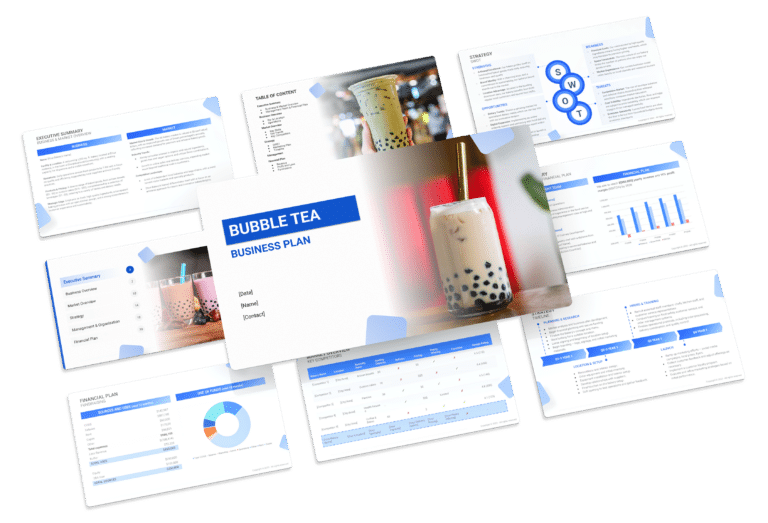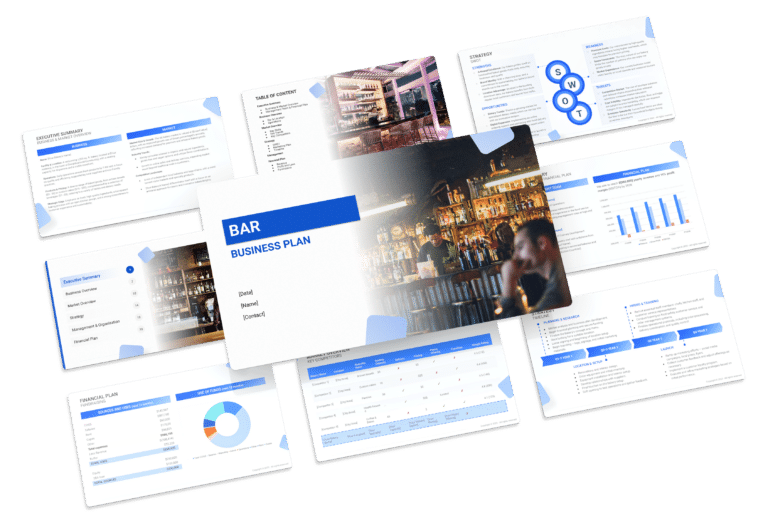Brewery Business Plan Template & PDF Example

Creating a comprehensive business plan is crucial for launching and running a successful brewery. This plan serves as your roadmap, detailing your vision, operational strategies, and financial plan. It helps establish your brewery’s identity, navigate the competitive market, and secure funding for growth.
This article not only breaks down the critical components of a brewery business plan, but also provides an example of a business plan to help you craft your own.
Whether you’re an experienced entrepreneur or new to the food and beverage industry, this guide, complete with a business plan example, lays the groundwork for turning your brewery concept into reality. Let’s dive in!
The Plan
Our brewery business plan is structured to cover all essential aspects needed for a comprehensive strategy. It outlines the brewery’s operations, marketing strategy, market environment, competitors, management team, and financial forecasts.
- Executive Summary: A quick overview of the Brewery’s concept, market potential, team, and financial strategy.
- Business Overview: Insights on the Brewery’s offerings and operational model:
- Brewery & Equipment: Details on the brewery’s location, equipment, and production capacity.
- Beer Offering & Pricing: Lists beer types, special releases, and pricing strategy.
- Market Overview: Analysis of the brewery market, highlighting your position:
- Key Stats: Presents the size and growth of the craft brewery market.
- Key Trends: Points out trends like innovative flavors and eco-conscious brewing.
- Key Competitors: Identifies your main competitors and your unique selling points.
- Strategy: Outlines the plan for growth and customer engagement:
- SWOT: A brief analysis of strengths, weaknesses, opportunities, and threats.
- Marketing Plan: Short strategies for promoting the brewery and its beers.
- Timeline: Major milestones from setup to the first year’s end.
- Management: Gives information on the leadership team and their roles.
- Financial Plan: Forecasts the brewery’s finances over 5 years, covering income, expenses, and profitability.

Executive Summary
The Executive Summary presents an overview of your brewery’s business plan, succinctly describing the brewery and its offerings. It will highlight your market positioning, the variety of beers and related products you plan to brew, its location, size, and a snapshot of daily operations.
This section will also delve into how your brewery intends to establish itself within the local market, including an analysis of the number of direct competitors in the vicinity, who they are, and your brewery’s unique selling propositions that set it apart from these competitors.
Moreover, it should outline the management and co-founding team, specifying their roles and how they contribute to the brewery’s success. In addition, a brief on your financial forecasts, including expected revenue and profit margins over the next five years, should be included to offer a transparent view of your brewery’s financial strategy.
Brewery Business Plan Executive Summary Example
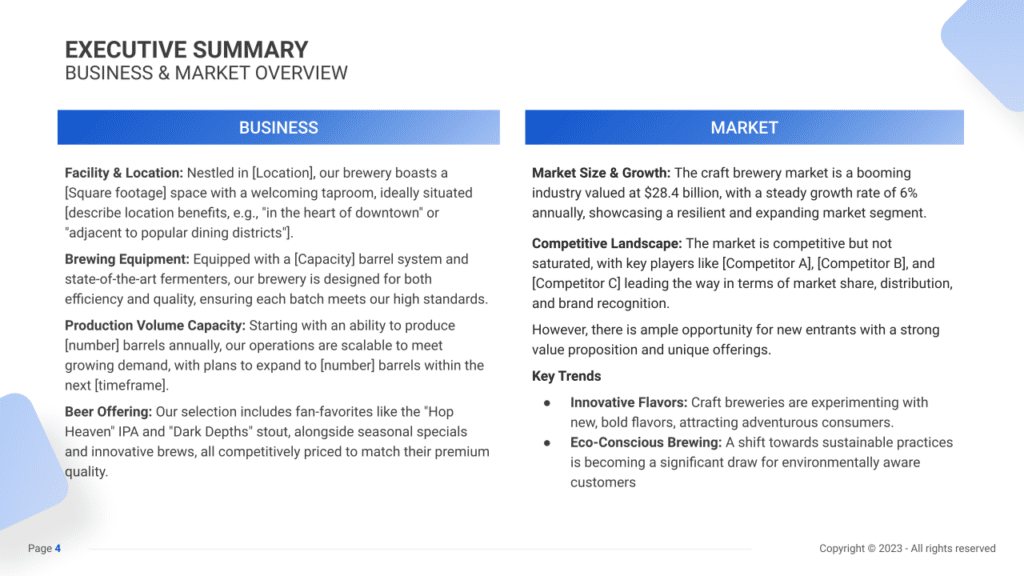
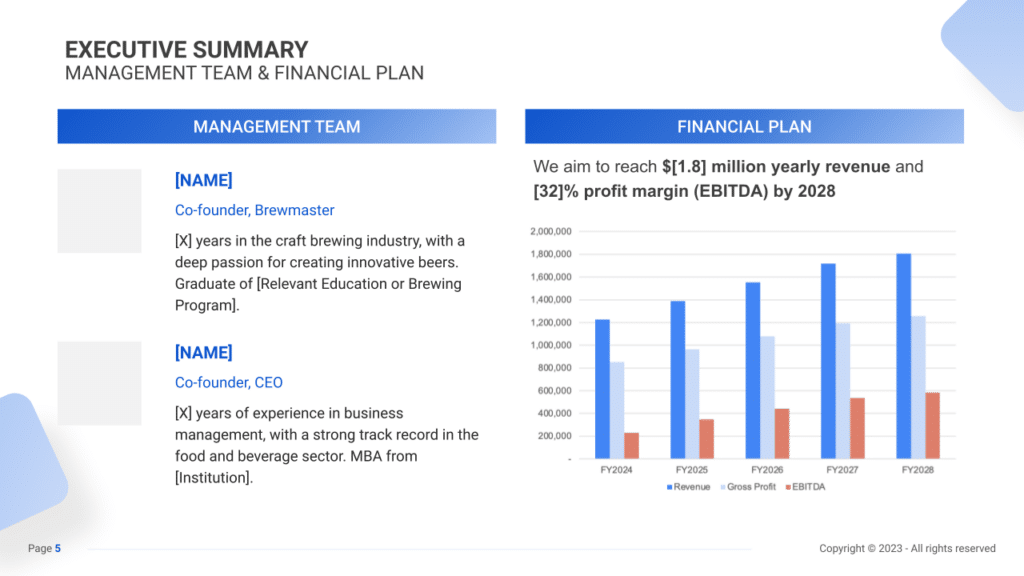
Business Overview
The business overview should clearly define the brewery’s key characteristics, including its location, brewing equipment, production volume capacity, and beer offerings. Emphasizing what sets your brewery apart, such as unique flavors or sustainable brewing practices, is crucial for attracting interest and investment.
Example:
“CraftHaven Brewery,” nestled in Downtown Riverdale, features a 5,000-square-foot space with a cozy taproom. Equipped with a 10-barrel brewing system, the brewery has an initial production capacity of 2,000 barrels annually, scalable to 5,000 barrels. CraftHaven’s beer lineup, including the popular “Hop Heaven” IPA and “Dark Depths” stout, showcases innovative flavors and seasonal specials, appealing to a wide range of craft beer enthusiasts.
Market Overview
This section should analyze the craft brewery market’s size, growth trends, and competitive landscape. It positions your brewery within the industry and highlights its potential to capitalize on current consumer preferences and market opportunities.
Example:
CraftHaven Brewery enters a robust market valued at $28.4 billion, growing steadily at 6% annually. Despite competition from established breweries like Competitor A and B, CraftHaven distinguishes itself with its focus on innovative flavors and commitment to eco-conscious brewing, catering to the preferences of adventurous and environmentally aware customers.
Management Team
Detailing the management team’s background and roles is essential. This part of the summary should emphasize their experience in the craft brewing industry and business management, highlighting their ability to lead the brewery to success.
Example:
The Brewmaster, a veteran with years of experience in craft brewing and a graduate of a prestigious brewing program, leads the beer production. The CEO, with an MBA and a strong track record in the food and beverage sector, oversees the brewery’s overall strategy and business operations.
Financial Plan
Clearly outlining the financial goals and projections is key. This section should include targets for revenue and profit margins, offering insight into the brewery’s financial health and growth potential.
Example:
CraftHaven Brewery aims to achieve $1.8 million in annual revenue with a 32% EBITDA margin by 2028. Supported by a strategic approach to marketing, quality beer production, and a focus on customer experience, the brewery is positioned for significant growth in the dynamic craft beer market.
Business Overview
For a Brewery, the Business Overview section can be effectively divided into 2 main parts:
Brewery & Equipment
Detail the brewery’s physical setup, focusing on the design, brewing capacity, and the state-of-the-art equipment used in the beer-making process.
Highlight the brewery’s location, emphasizing its accessibility and the convenience it offers to visitors, such as proximity to popular dining or entertainment areas or ease of parking. Discuss why this location is strategically chosen to attract your target market.
Beer Offering & Pricing
Describe the range of beers and related products offered, from classic ales and lagers to innovative craft and seasonal brews. Explain your pricing strategy, ensuring it reflects the quality and uniqueness of your offerings and aligns with the market you’re targeting.
Emphasize any special releases, subscription models, or loyalty programs that add value for your customers, fostering repeat visits and a strong brewery community.

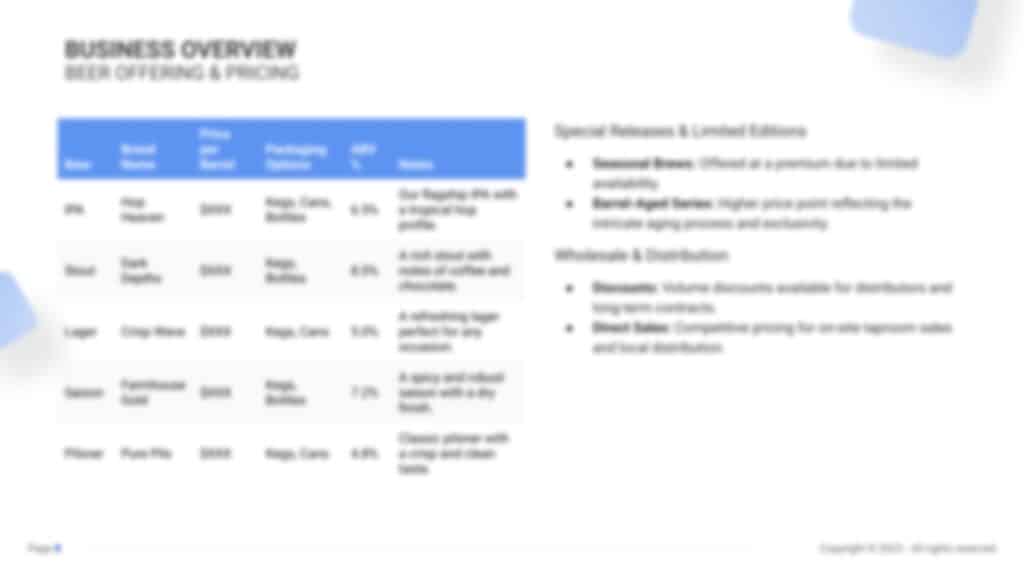
Market Overview
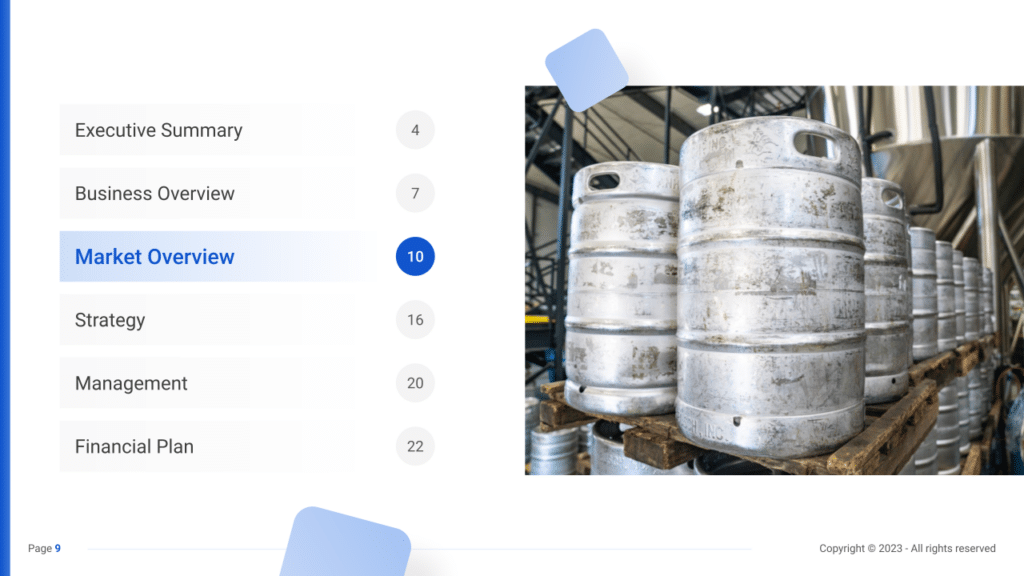
Industry size & growth
In the Market Overview of your brewery business plan, begin by exploring the size of the craft beer and brewing industry along with its growth potential. This analysis is vital for grasping the market’s breadth and pinpointing opportunities for expansion.
Key market trends
Continue by discussing recent trends in the market, such as the growing consumer interest in craft and artisanal beers, the preference for local and sustainable brews, and the innovation in beer flavors and brewing techniques.
Highlight the demand for beers that offer a unique experience, such as those using locally sourced ingredients or those that cater to niche tastes, alongside the increasing popularity of breweries that emphasize environmental sustainability and community engagement.
Competitive Landscape
A competitive analysis is a crucial element in understanding the position of your brewery in the market and is an essential part of your business plan. This analysis aids in pinpointing your brewery’s unique selling points, vital for standing out in a competitive industry.
Moreover, a competitive analysis is fundamental in building a strong foundation for your business plan. By examining the operational aspects of your competitors, you gather valuable information that ensures your business plan is comprehensive, well-informed, and designed to thrive in the brewery market.
Identifying Your Competitors in the Brewing Industry
Identifying competitors is the first step in understanding your position in the brewing market. Begin by mapping out local and regional breweries. For instance, if your brewery specializes in craft beers, your direct competitors include nearby craft breweries as well as larger beer companies that have entered the craft market. Don’t overlook indirect competitors such as local bars or pubs that offer a wide selection of beers, including those from competing breweries.
Use online tools like Google Maps to get a geographical sense of competitor distribution. Platforms like Untappd and RateBeer offer customer reviews and ratings, providing insights into competitors’ strengths and weaknesses. For example, if several reviews praise the unique seasonal brews at “Crafty Ales,” this is a key strength of your competitor.
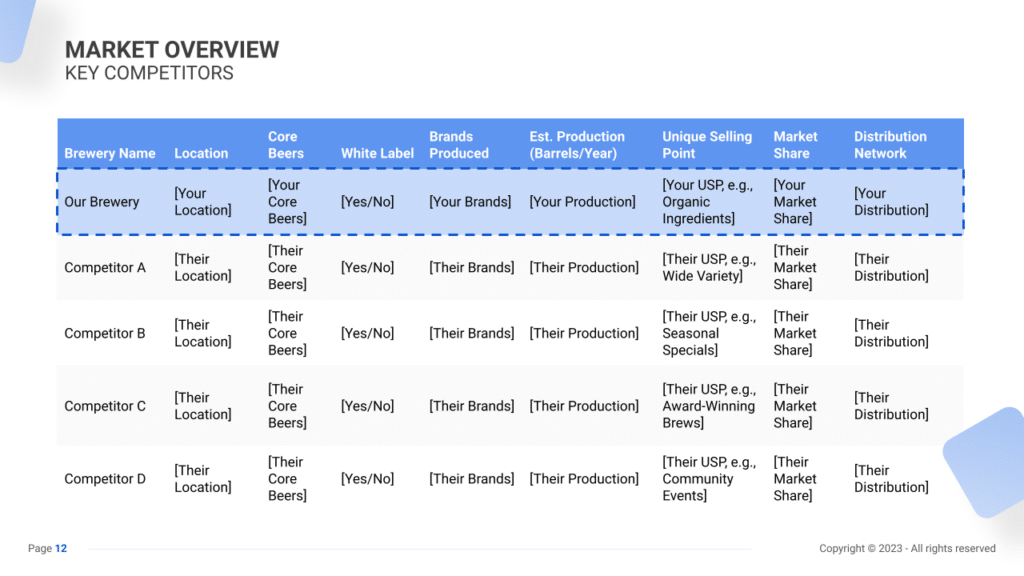
Brewery Competitors’ Strategies
Analyzing the strategies of these competitors involves several aspects:
- Core Beers: Examine their core beer offerings. If “Hops Haven” is gaining popularity with its diverse IPA range, it indicates a market trend towards hop-forward beers.
- Brewing Techniques: Consider the brewing techniques and styles. A brewery like “Traditional Brews” that focuses on classic styles might appeal to a different customer base than one like “Innovative Brews,” known for experimental and unconventional beers.
- Pricing Strategy: Compare your pricing with that of competitors. Are your beers priced similarly to “Budget Brews” or are they more aligned with the premium offerings at “Exclusive Ales”?
- Marketing Tactics: Look at how competitors market their products. Do they have a strong social media presence like “Social Sips,” or do they rely more on community events and word-of-mouth?
- Customer Experience: Assess the taproom or brewery tour experience. For instance, “Friendly Ferments” might be known for its welcoming atmosphere and knowledgeable staff, enhancing the customer experience.
- Operational Efficiency: Observe if competitors are using technology or innovative processes to streamline brewing and serving, much like “Techie Taps” with its automated brewing system.
What’s Your Brewery’s Value Proposition?
Reflect on your brewery’s unique value proposition. Maybe your brewery is known for using locally sourced ingredients, or perhaps you offer a unique range of barrel-aged beers that aren’t available elsewhere in your area.
Identify market gaps through customer feedback and industry trends. For example, the rising interest in sustainable and eco-friendly brewing practices could represent a market opportunity if competitors are not addressing this demand.
Consider your location: A brewery in a bustling downtown area might focus on creating a vibrant taproom experience, while a rural brewery could capitalize on its scenic location to become a destination for beer tourism.
Strategy

SWOT
Begin with a SWOT analysis for the brewery, identifying Strengths (such as a unique beer selection and strong brand identity), Weaknesses (including potential high startup costs or market saturation), Opportunities (for instance, the growing craft beer movement and local food pairing events), and Threats (like changing regulations or economic factors that may impact discretionary spending).
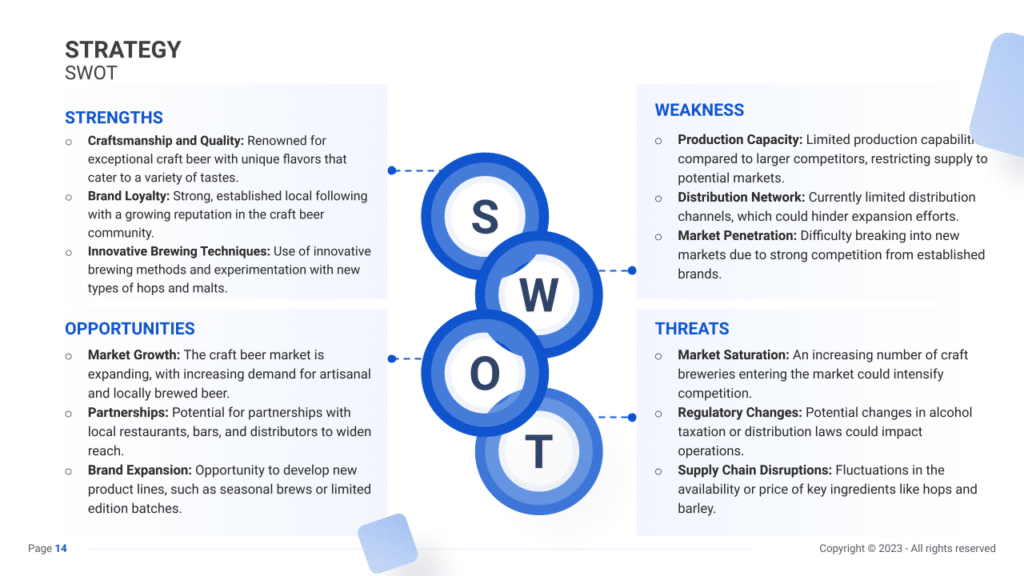
Marketing Plan
Then, formulate a marketing plan that details strategies for drawing in and keeping customers through targeted advertising, special brewery events, an active and engaging social media presence, and involvement in local community events and festivals.
Marketing Channels
Digital Marketing
- Social Media Engagement: In today’s digital era, leveraging various online platforms is critical for establishing a strong brewery presence. Social media platforms like Instagram, Facebook, and Twitter serve as avenues to showcase your brewery’s story, share behind-the-scenes glimpses of the brewing process, and engage with beer enthusiasts.
- Email Marketing: Build an email list for brewery updates, exclusive beer releases, and events. Offer incentives like access to limited-edition beers or discounts for subscribers.
- Website and SEO: A professionally designed website acts as a central hub for all brewery-related information, including beer offerings, taproom events, online merchandise sales, and engaging blog content related to the brewing industry. Optimizing your website for local SEO ensures that your brewery ranks prominently in online searches for beer-related queries within your geographical area.
Local Advertising
- Community Involvement: Community involvement and local outreach efforts are powerful tools for creating brand awareness and fostering connections within your locality. Sponsor local events, participate in community fairs, and collaborate with nearby businesses to expand your brewery’s visibility.
- Print and Media: Print media, including local magazines, newspapers, and strategically placed posters or flyers in local hangout spots, contribute significantly to reaching a broader audience within your vicinity.
Partnerships and Collaborations
- Collaborate with Bars and Restaurants: Forming partnerships and collaborations within the industry can amplify your brewery’s reach and customer base. Collaborate with bars, restaurants, or cafes to feature your brews on their menus or create exclusive beer collaborations.
- Events and Festivals: Participating in events, such as beer festivals or industry expos, allows for networking opportunities and exposure to a wider audience. Collaborate with food vendors or artists during these events to enhance the overall experience for attendees.
Promotional Activities
- Limited Releases and Special Events: Launch limited-edition beer releases or seasonal brews to create buzz and attract beer enthusiasts.
- Loyalty Programs: Implement a loyalty system offering rewards or discounts for frequent taproom visitors or repeat customers.
- Referral Programs: Incentivize customers to refer friends by offering discounts or exclusive access to brewery events.

Sales Channels
Taproom Sales
- Enhance Customer Experience: Train staff to upsell by suggesting beer pairings, recommending merchandise alongside purchases, and educating customers about your brewing process and beer varieties. Create an inviting ambiance in the taproom that aligns with your brewery’s brand, encouraging customers to spend more time and explore various offerings.
- Merchandise Sales: Display branded merchandise prominently and offer it as part of bundled deals or promotions.
Online Sales and Distribution
- E-commerce Platform: Expanding beyond the taproom, establishing an online sales platform broadens your brewery’s reach. Developing a user-friendly e-commerce platform allows customers to purchase your beers, merchandise, and gift cards conveniently from anywhere.
- Local Delivery or Shipping: Consider offering local delivery services or partnering with delivery platforms to ensure timely beer deliveries to customers’ doorsteps. Additionally, explore opportunities for shipping your beers to regions beyond your immediate locality to cater to a broader market.
Membership and Subscription Programs
- Membership Benefits: Create a beer club or subscription model offering members exclusive access to limited-edition releases, discounts on merchandise, or brewery events.
- Subscription Boxes: Curate monthly beer subscription boxes featuring a variety of brews for customers beyond your local area.
Strategy Timeline
Lastly, establish a comprehensive timeline that marks key milestones for the brewery’s launch, marketing initiatives, customer base development, and growth goals, ensuring the business progresses with clear direction and intent.

Management
The Management section focuses on the brewery’s management and their direct roles in daily operations and strategic direction. This part is crucial for understanding who is responsible for making key decisions and driving the brewery towards its financial and operational goals.
For your brewery business plan, list the core team members, their specific responsibilities, and how their expertise supports the business.
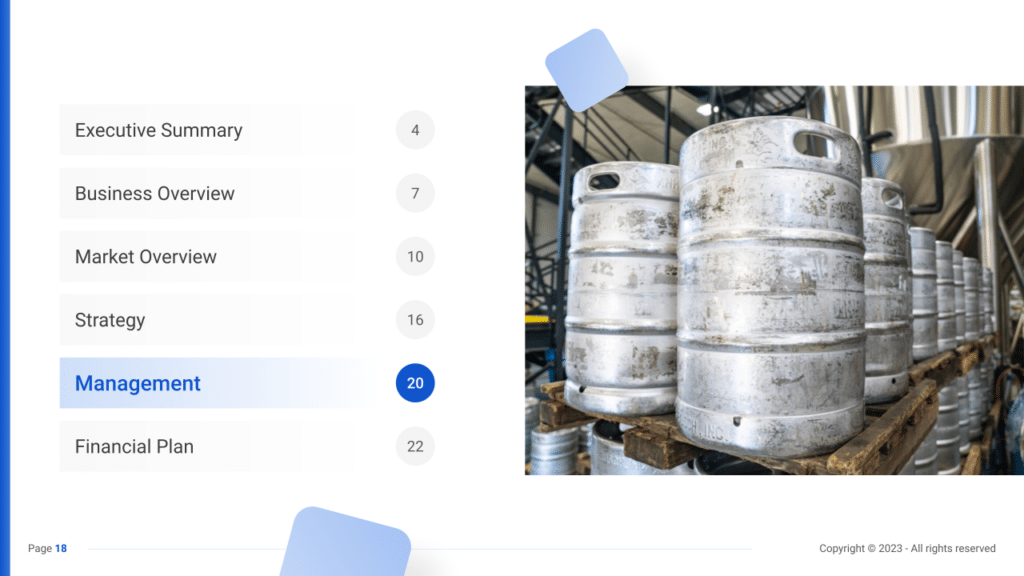

Financial Plan
The Financial Plan section is a comprehensive analysis of your financial projections for revenue, expenses, and profitability. It lays out your brewery’s approach to securing funding, managing cash flow, and achieving breakeven.
This section typically includes detailed forecasts for the first 5 years of operation, highlighting expected revenue, operating costs and capital expenditures.
For your brewery business plan, provide a snapshot of your financial statement (profit and loss, balance sheet, cash flow statement), as well as your key assumptions (e.g. number of customers and prices, expenses, etc.).
Make sure to cover here
_ Profit and Loss
_ Cash Flow Statement
_ Balance Sheet
_ Use of Funds







